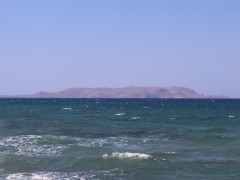Zeus Island - Crete

Off the northern coast of the Greek island of Crete lies the permanently uninhabited island of Zeus, which serves mainly as a nature reserve for protected species of plants and animals. However, you can go to the island, as there is a small cruise ship dock off its southern coast.
Crete - characteristics of the island of Zeus
The island of Zeus is located about 6 nautical miles north of Heraklion, the capital of Crete. The island measures approximately 5 km in length and 3 km in width and covers an area of 12 km2. After Gavdos, Zeus is the second largest of the islands scattered around Crete (almost 90 in total). To the east and west of the island of Zeus are the two small islands of Paximadi and Petalidi.
The surface of the island is mostly rocky and covered with bushes and provides an important refuge for many native plants and animals. Zeus is part of the Natura 2000 nature conservation programme. Here you can see, for example, rare bird species, including the local falcon, or several species of wild rabbits that pop out of the bushes every now and then. The island is also home to the wild Kri-Kri mountain goat, a protected species of lizard, the snail and the endangered Cretan ibex.
Cruise ships from Crete head to the southern coast of Zeus, where there are five main, quiet coves - Agios Georgios, Kapari, Panagia, Agrielia and Aginara. The island's only port is located in the bay of Agios Georgios. The beautiful Venetian chapel of Analipsis still stands on the island, but otherwise there are no buildings or roads, and the island of Zeus is not permanently inhabited. Ships traditionally sail to Zeus from the Cretan ports of Gouves, Hersonissos and Heraklion.
History of the Cretan island of Zeus
The island of Zeus played an important role especially in the Minoan period and in the following ones, when it served as an important navigation point. For sailors, it signalled the proximity of the Cretan coast and also provided shelter from the strong north winds. In Minoan times, the island of Zeus was inhabited, and a small fishing village existed near the port of Agios Georgios.
During the Venetian rule, the island was known as Standia and the sheltered bays in the south of the island served as trading ports.
When in the 1970s the French explorer Jacques Y. Cousteau searched the area between Crete and Santorini for the lost Atlantis, he discovered seven ancient shipwrecks on the seabed off the island of Zeus. Not far afterwards, he also found square and rectangular stones that had previously served as breakwaters, confirming the existence of an ancient Minoan port on the island of Zeus.
Zeus island in Greek mythology
According to ancient legends, the island was created by Zeus himself. While sitting on his throne on Olympus, he looked down on Crete, his birthplace. But what he saw angered him greatly. He saw how the Cretans hunted with bows and spears and almost exterminated his beloved wild goats. For these goats were the offspring of Amalthea, the goat who had fed little Zeus with her milk while he hid from his father Cronus in the cave. Enraged, Zeus struck the sea with lightning, and a huge monster emerged from the sea and began to devour the Cretans. The other gods tried to appease Zeus' wrath, and Poseidon, the god of the sea, said: "My king, how can you destroy the Kourites like this? Do you thus repay them for the good they have done for you?" For the Kourites were the Cretans who banged loudly on their shields when little Zeus cried so that his father Kronos would not hear him.
Zeus immediately changed his mind at this reminder. He took two pieces of rock and threw them to Crete as biscuits for the sea monster. When the monster lunged for them, Zeus stoned the monster with lightning. Thus the sea monster became the island of Zeus and the two small rock biscuits became the islands of Paximadi and Petalidi. If you look in the direction of Heraklion, it is said that the shape of the island actually resembles a giant lizard.
According to another legend, Theseus and Ariadne also fled to the island of Zeus after the hero killed the dreaded Minotaur.
More touristic destinations of Crete
Tips for trips on Crete: Cretaquarium (sea aquarium), Zeus Caves, Kournas Lake, Minoan Palaces, Zeus Island, Gramvousa Island, Samaria Gorge, Waterpark Water City
Resorts, beaches, sights or trips - clearly listed on the map of Crete.
Did you visit this place and do you have some additional informations, interessting observation or photos?

